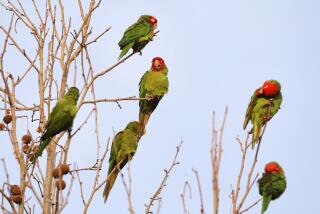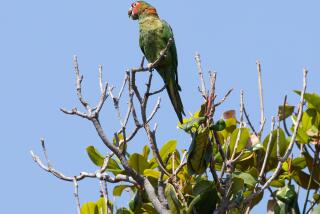London’s Sparrows in Free Fall
- Share via
LONDON — They disappeared so quietly that few noticed them go, nor perceived the silence they left beneath the thrumming layers of city noise.
In their dusty gray-and-brown jackets, house sparrows were so common that their steep slide in major British and Irish cities went unremarked for years.
“The decline has been massive. In London, Glasgow, Edinburgh, Dublin, the population has fallen by 99% since 1980,” said Dennis Summers-Smith, one of the world’s leading sparrow experts. “This is almost extinction.”
The house sparrow will go on Britain’s endangered species “red list” this year. Yet it is still officially a pest that can be exterminated. In fact, sparrow-proof bird feeders are still sold in London.
In the U.S., the birds are often seen as a kind of feathered mice--not just drab and dull birds, but invaders. Yet Londoners have a special affection for these perky little creatures, which were always a garrulous companion to the city’s cockneys, no matter how humble the garden.
And British bird-watchers drift out of their serious, scientific commentaries into sentimental reflections on sparrows’ antics and their affinity with people.
The fate of the sparrow has ornithologists mystified, and the Independent newspaper has offered a epartment5,000 [$7,600] reward to solve the puzzle.
“There are lots of theories but no good answers yet,” said Keith Noble, London sparrows officer for Britain’s Royal Society for the Protection of Birds. He cited food shortages, predators, changes in farming methods and pollution as possible causes for the birds’ disappearance. Summers-Smith warns that the decline of the sparrow may point to dangers for humans not just in London, but in major cities everywhere. The numbers of sparrows are dropping in many large European cities as well as the big cities in Britain, he points out.
“If one bird declines dramatically, something funny is going on, and since most of us live in cities, I think we ought to know why it’s happening,” Summers-Smith said by phone from his home in northern England.
“Birds are indicators of the quality of life,” he said. “Is the house sparrow the modern equivalent of the miners’ canary, telling us something nasty is going on in our cities?”
The sparrow population in Britain is reported to be 673,000, a 57% drop since 1979.
Squinting at the pockmarked walls of one of London’s most famous landmarks, the Tower of London, sparrow researcher Sandy Alcorn, 48, strained to hear the once common chirrup.
Last year, she counted eight sparrow nests in and around the tower, this year only four.
“Maybe when I come back this time next year, there’ll be no sparrows left here,” she said. In 1925, ornithologist Max Nicholson, 21, counted 2,603 sparrows in central London’s Kensington Gardens. This summer, only four male sparrows found their way into the park, and not one found a mate.
Last year, there were hatchlings, but none survived.
Nicholson also believes that the decline of the sparrow contains a vital message for humans. Speaking at his Chelsea home, he said humans are less sensitive than birds to environmental changes.
“If we were like 17th century Londoners and could never get out of here, we’d be less happy to live here,” he said.
When Nicholson started counting sparrows nearly eight decades ago, the bird was so common it was ignored by most ornithologists.
“Everybody knew the sparrow, of course. Very few paid much critical attention. Even among the bird-watchers it was considered rather boring. You went out and found rare birds in the Highlands rather than spending your time on sparrows in London,” he said.
“I saw the sparrow [numbers] as being on the crest of a wave,” he said. “The idea that the sparrow would practically disappear from London never occurred to us.”
Hundreds of Londoners are taking part in a survey--sponsored by the London Biodiversity Partnership, a coalition made up of the Royal Society for the Protection of Birds and other wildlife and ecological groups--to count sparrows in their neighborhoods. The aim is to find pockets where the bird is more plentiful and uncover clues as to why.
Amanda Rudd, a project manager at the London Wildlife Trust, said people were so used to thinking of the bird as common that their disappearing act took the city by surprise.
“But when you ask people, ‘When was the last time you saw one?’ they say, ‘I don’t remember,’ ” she said.
The house sparrow also is declining sharply in the U.S., but there is no alarm among American ornithologists because the bird is an imported species: 100 house sparrows were brought to Brooklyn in 1851 and 1852, while others were introduced to San Francisco and Salt Lake City in 1873 and 1874.
“Folks have generally frowned upon it [the sparrow],” said Keith Pardieck, head of the North American Breeding Bird Survey at the Patuxent Wildlife Research Center in Maryland. He confirmed a 2.5% annual decline in the house sparrow population since 1966.
If the bird were native, people would be alarmed, he said, calling the sparrow “an invasive species.”
The number of sparrows in North America is estimated at 150 million, according to the Cornell Laboratory of Ornithology.
Nicholson said the sparrow was introduced to Britain about 400 years ago, coming from India and South Asia through Iran and Turkey to Vienna and other parts of Europe.
Roy Sanderson, 72, who bands the legs of birds to identify and track them, followed the fortunes of the four unlucky male sparrows in Kensington Gardens this summer. He decided against banding them in case it disturbed them.
“The sparrow followed man around the world. It’s always been at man’s right arm,” he said. “Now it’s turning its back on us. I think it’s very important to know why.
“The sparrow’s become important because it’s created a mystery. We’re still hoping that someone will take this on as a challenge.”
Beyond the mystery and the importance to humans of knowing the answer, there is, to sparrow watchers here, a pathos about the disappearance of a bird so identified with London and so taken to heart by the East End’s cockneys.
“It was a part of London folklore, the sparrow. It was the cockney ‘sparrer.’ The East Enders didn’t see a lot of birds, but the sparrow was always around in their gardens,” Sanderson said.
Alcorn never took much notice of the bird until she began studying the Tower of London sparrows and two other colonies in East London for a diploma in ecology and conservation at Birkbeck College in London 18 months ago.
“You start out mildly interested and end up obsessed,” she confessed. “You’ve heard of the cockney sparrow, small and perky but big personality. They’re very entertaining to watch. They’re funny little fellows. I think the city would be a very dull place without them.
“There are kids now in London who don’t know what a sparrow looks like, and I think that’s sad. If I was raising kids in London, I’d be thinking, ‘If it isn’t habitable by birds, is it habitable by people?’ ”
Alcorn took a British television documentary crew to observe the Tower of London sparrows last year, and it was like tracking a rare jungle bird: They waited 2 1/2 hours to spot one.
But this month the sparrows were out, pecking the seed heads of summer grass, chirruping loudly, with heads cocked fetchingly.
“This little guy took food from my hand last week and the week before,” Alcorn said. “They are cute, aren’t they? It’s not just me.”
To Alcorn’s chagrin, most of the 12 to 15 young sparrows that hatched this summer near the tower were either eaten, died or flew off. She finds it alarming that such an adaptable and intelligent bird is now in such a precarious situation.
“This little fellow is tough and a survivor if ever there was one,” she said.
She has seen sparrows pluck insects from spiders’ webs and car radiators, nip food from pigeons’ beaks and copy other birds pecking the tops of milk bottles.
One theory for their disappearance is that their favorite nesting places--holes and cracks in roofs--have become scarce because modern roofing materials are tougher than they used to be. But Sanderson said there were plenty of nesting sites in Kensington Gardens this year, and Alcorn said the Tower of London also afforded plenty of roosting places.
Another theory is scarcity of food because farmers plow and sow crops twice a year, instead of only once, meaning that fields don’t lie fallow providing winter food. Other theories include predators, a mystery virus, or competition for food from other species.
Summers-Smith discounted these theories. There were no large numbers of corpses that would suggest a virus, he explained. And sparrows remain common in small towns close to farmland, predators and other species competing for food.
His theory is that toxic emissions of lead-free gasoline, introduced in London in 1989, may be killing off insects, the only food that baby sparrows can eat.
With millions of birds in other parts of the world, why not simply transfer birds to London to replace the sparrows, if Londoners feel so strongly about them?
Alcorn said that even if sparrows could be transferred to London, they would probably face the same fate as the few remaining in the city. Like other sparrow populations, they would gradually disappear. Summers-Smith agreed.
“It’s not addressing the problem,” he said. “It’s only addressing the symptoms. We’ve got to understand what’s happening.”
More to Read
Sign up for Essential California
The most important California stories and recommendations in your inbox every morning.
You may occasionally receive promotional content from the Los Angeles Times.










